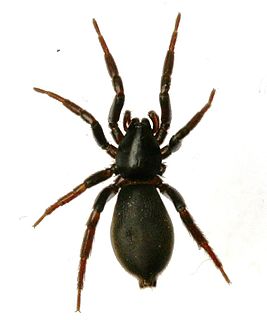
The Pholcidae are a family of araneomorph spiders. The family contains over 1,800 pholcids, including those commonly known as the marbled cellar spider , daddy long-legs spider, granddaddy long-legs spider, carpenter spider, daddy long-legger, vibrating spider, gyrating spider, long daddy, and skull spider. The family, first described by Carl Ludwig Koch in 1850, is divided into 94 genera.

Ground spiders comprise Gnaphosidae, the seventh largest spider family with nearly 2,000 described species in over 100 genera distributed worldwide. There are 105 species known to central Europe, and common genera include Gnaphosa, Drassodes, Micaria, Cesonia, Zelotes and many others. They are closely related to Clubionidae. At present, no ground spiders are known to be seriously venomous to humans.

Zelotes subterraneus is a species of ground spider from the family Gnaphosidae which has a Palearctic distribution. it is the type species of the genus Zelotes. Its distribution may be somewhat masked by the difficulty of distinguishing this species from Zelotes apricorum and Zelotes latreillei.

Xysticus funestus, or deadly ground crab spider, is a species of crab spiders in the family Thomisidae. It is found in North America.

Orthocephalus is a genus of plant bugs in the family Miridae. There are more than 20 described species in Orthocephalus.
Enoplognatha marmorata, the marbled cobweb spider, is a species of cobweb spider in the family Theridiidae. It is found in North America.

Haplodrassus signifer is a species of ground spider in the family Gnaphosidae. It is found in North America, Europe, Turkey, Israel, Caucasus, a range from Russia to Central Asia, China, and Korea.
Zelotes duplex is a species of ground spider in the family Gnaphosidae. It is found in the United States and Canada.
Zelotes lasalanus is a species of ground spider in the family Gnaphosidae. It is found in North America.
Zelotes puritanus is a species of ground spider in the family Gnaphosidae. It is found in North America, Europe, Turkey, and a range from Russia to Kazakhstan.
Zelotes tenuis is a species of ground spider in the family Gnaphosidae. It is found in a range from Mediterranean to Russia (Caucasus), has been introduced into Galapagos Islands, and the United States.

Zelotes pseustes is a species of ground spider in the family Gnaphosidae. It is found in the United States and Mexico.
Clubiona riparia, the riparian sac spider, is a species of sac spider in the family Clubionidae. It is found in Russia, Mongolia, China, Japan, and North America.

Theridion melanurum is a species of cobweb spider in the family Theridiidae. It is found in a range from Europe to Siberia, Macaronesia, North Africa, Middle East, and has been introduced into the United States.
Aradus funestus is a species of flat bug in the family Aradidae. It is found in North America.
Zelotes fratris is a species of ground spider in the family Gnaphosidae. It is found in Russia (Siberia) and North America.
Zelotes hentzi is a species of ground spider in the family Gnaphosidae. It is found in the United States and Canada.
Zelotes anthereus is a species of ground spider in the family Gnaphosidae. It is found in the United States.

Nemoria zelotes is a species of emerald moth in the family Geometridae. It is found in North America.
Anopheles funestus is a species of mosquito in the Culicidae family. This species was first described in 1900 by Giles. The female is attracted to houses where it seeks out humans in order to feed on their blood, mostly during the night. This mosquito is a major vector of malaria in sub-Saharan Africa.








